

A fond farewell to Parks Tower
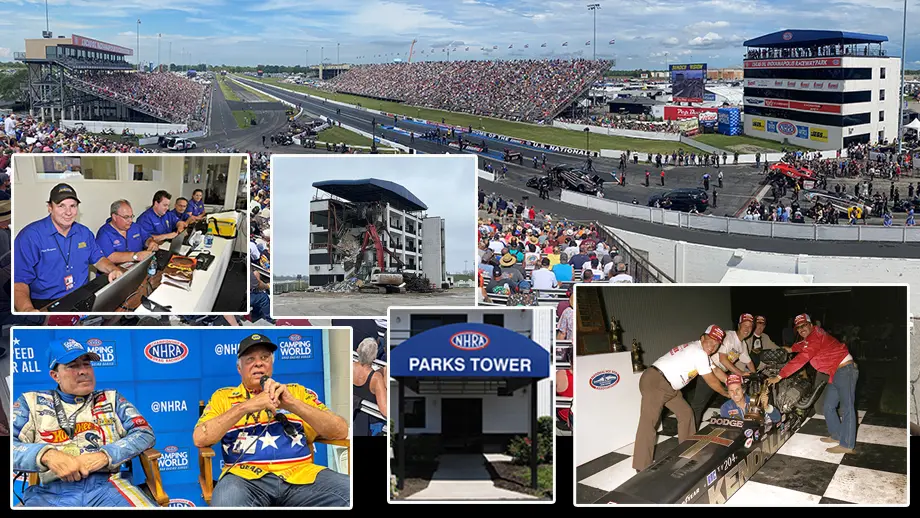
Imagine driving onto the block where you grew up and discovering that the house in which you grew up was gone. That’s going to be a bit of the feeling for me when I pull into Lucas Oil Indianapolis Raceway Park later this year and see the Parks Tower gone. It's the only Indy home I've known.
The venerable four-story building, constructed in 1983, was as much a part of the Indy landscape as was the D-A Tower that stood sentinel over the starting line since 1961 or the Hurst crossover bridge that spanned the approach lanes beginning in 1967.

The Parks Tower, easily one of the first things you would see on approach to the gates, stood watch over four decades of Indy history and, from our second-story perch, provided a great vantage point for those of us in the media to take in the spectacle of the Big Go, a place to interview the drivers after their victories, and a place to call home for the week-long marathon that is the world’s biggest drag race.
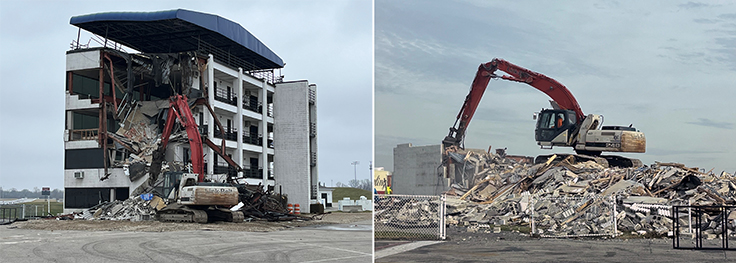
As you probably all know, the tower was torn down earlier this month, painfully picked apart chunk by chunk until it was reduced to a pile of rubble, and with each ravaging bite of the excavator’s claw, a little piece of me died with it.
It’s been there for as long as I’ve been coming to Indy, and unless you’re an OG fan, it’s probably the same for you. Even though I was hired at NHRA National Dragster in May 1982, I didn’t get to go to the ’82 U.S. Nats and missed seeing stunning runs like Gary Beck’s 5.48 (the first sub-5.5-second Top Fuel run) or Don Prudhomme’s jaw-dropping 5.63 in Funny Car (a run that wasn’t bettered for almost three years).
My first trip to the fabled facility was in the spring of 1983 for the SPORTSnationals, which had just moved to Indy that year after being rained out in Houston the previous season. After having seen the track on TV and in magazines for decades, I couldn’t wait to set foot on its hallowed grounds but, much to my dismay, the fabled Hurst bridge that had been in the background of so many great photos had been dismantled to make room for the construction of the Parks Tower.
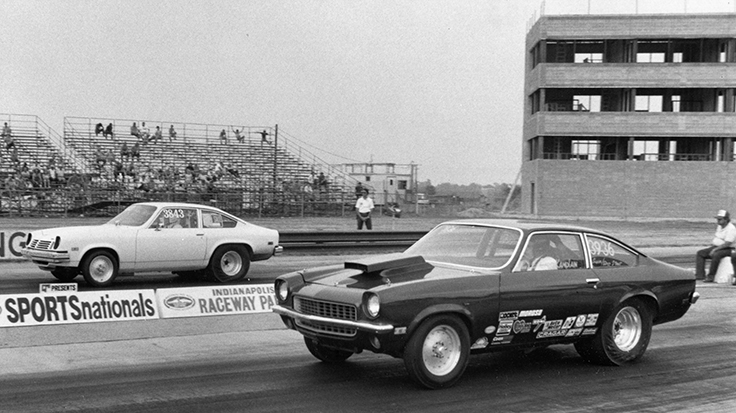
As you can see in the photo above, the Parks Tower was under construction during the SPORTSnationals and was completed in time for the U.S. Nationals.
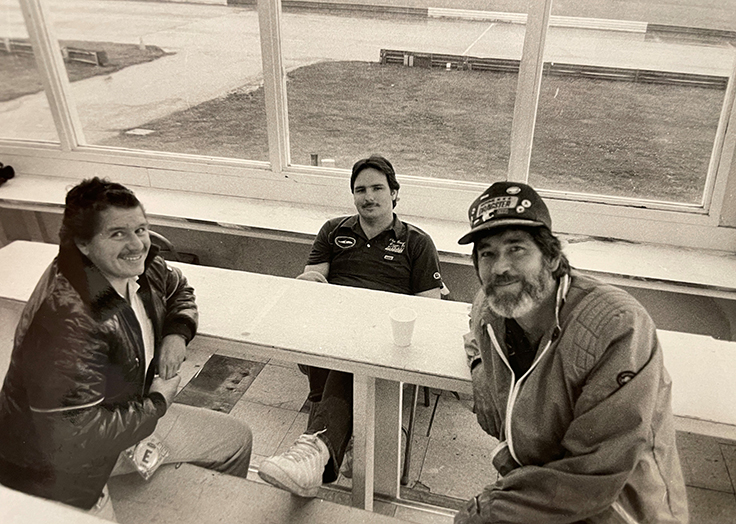
The SPORTSnats got rained out and was completed two months later (71 days later, to be exact). There was another tower in Indy at the time, a three-story building just beyond the finish line, known over the years as the TRW Tower of the Strange Tower, and I remember me, Leslie Lovett, and Auto Imagery’s Rick Shute seeking cover from the rain there.
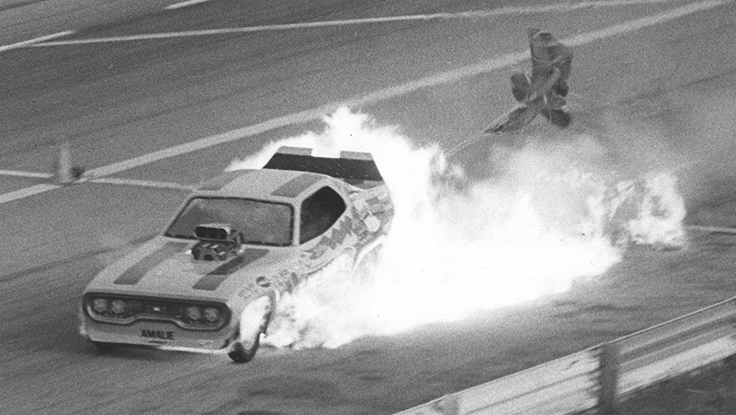
That grand old finish-line tower, which was removed in 2005, also had a rooftop photo stand that provided a platform from which some of Indy’s great crash and burn pics were taken over the years, iconic photos such as Norman Blake's sizzling shot of Shirley Muldowney’s Funny Car blaze at the 1973 event.
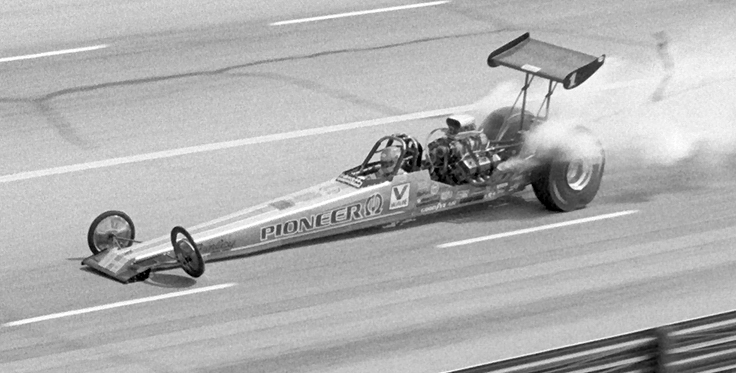
It’s also where I got my first taste of the thrill of top-end shooting, including this photo of Muldowney again in top-end peril exactly 10 years later when her Pioneer fueler broke a steering arm in the lights and where I was unknowingly being interviewed for the editor’s position by my soon-to-be boss Neil Britt. (I didn’t know he’d already been hired at the time. He was still working at Car Craft, as I recall, and began asking me questions like, “What would you do differently if you were in charge of National Dragster?”)
But back to the Parks Tower. Named, obviously, in honor of NHRA founder Wally Parks (and, assuredly, his wife, Barbara), the new tower had offices on the first floor and the media and race control shared the second floor, with VIP suites occupying the top two floors and a rooftop vantage point for race-watchers.
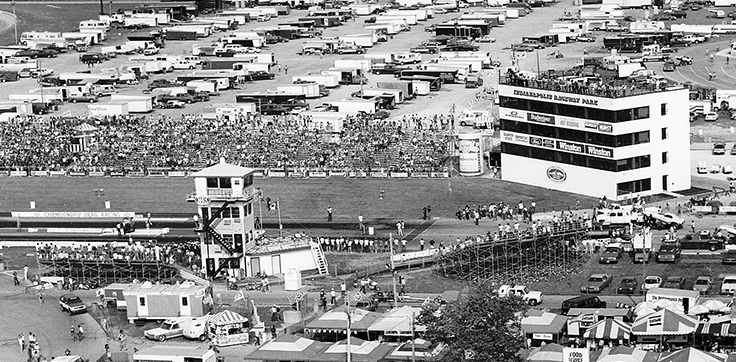
The original D-A tower starting-line tower, which had been home to the announcer and race control since the 1961 Nats, actually stayed through the 1984 event before being moved prior to the 1985 event and today still remains on IRP grounds, standing watch over Turn 4 of the oval course. Where the D-A tower stood is now the triangle grassy area so popular today with photographers.
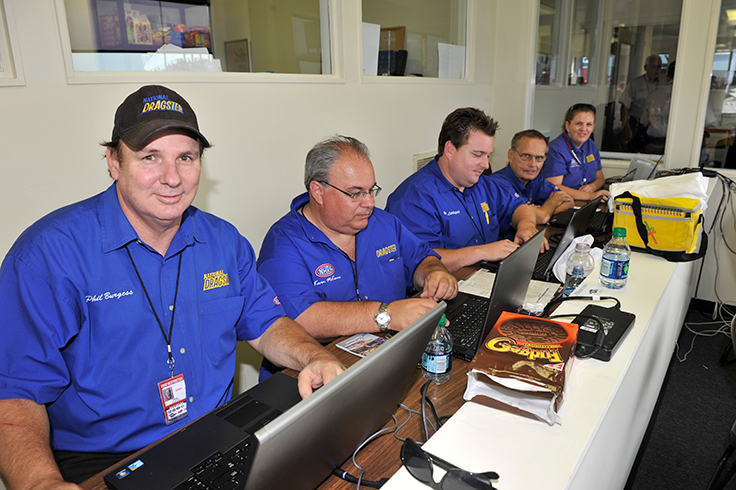
The new media room in the Parks Tower, which was named after Indianapolis Star reporter George Moore, who covered the event for decades, was split-level, with deadline media such as the ND team and daily newspapers on the lower part down on the glass and non-deadline (i.e., monthly mags, etc.) media on the higher level, which also housed an interview area that could accommodate about 30 reporters for end-of-day low qualifier interviews.
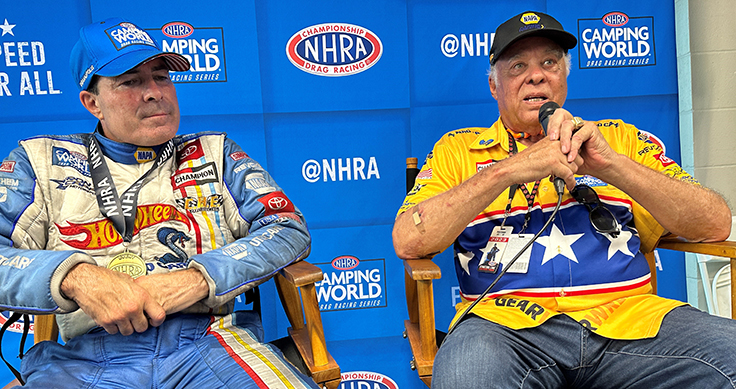
It was also in that area that we could engage with drivers who had just won the biggest events of their lives in a formal setting. Prior to that, many of our interviews took place during or immediately after the winner’s circle photo sessions, which were not exactly conducive to the process. We saw a lot of Tony Schumacher (10 wins!) and John Force (five wins) and listened to their recounts and grooved on the emotions of their victories all the way up through the amazing Ron Capps/Don Prudhomme victory last year.
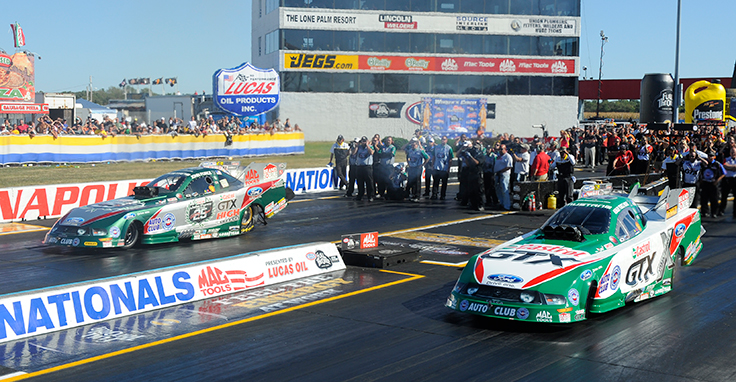
The view from the second-floor windows allowed us front-row seats to some of Indy’s great moments of the last 40 years: Jim Head’s stunning Funny Car win in 1984, Don Prudhomme’s 1989 Indy/Bud Shootout double-up, Pat Austin’s near double in Top Fuel and Top Alcohol Funny Car in 1991, the twin McDonald’s nitro wins by Ed McCulloch and Cruz Pedregon in 1992, Cory McClenathan’s emotional Top Fuel win in 1996 after the loss of Blaine Johnson, Gary Densham’s heartwarming Funny Car win in 2004, Ashley Force beating her father in the 2010 Funny Car final, Terry McMillen’s amazing Top Ful victory in 2018, and the list could go on and on.
For a while, National Dragster actually had a suite on the fourth floor to entertain advertising clients, and it was there that I had one of no-racing related "memorable" moments, as I wrote about in a 2010 event blog post titled, "Just Call Me McGyver."
At its most basic point, the U.S. Nationals is a series of mechanical challenges. Team versus team. Team versus the track. Team versus the parts.
And, this year, Man vs. Door.
You can get yourself into trouble in a lot of ways at a race as big as the U.S. Nationals. You can get run over in the pits. You can misquote a racer or blow a big story. You can walk into the wrong restroom. Or you can get yourself locked into a tower suite.
I know. It happened to me.
This is my story.
It was late Sunday and all of my NHRA.com work was largely done. I stepped out onto the back deck of the Parks Tower for a little fresh air and some stress relief, then figured I'd climb up to the fourth floor and see what was going on in the National DRAGSTER suite that so grandly overlooks the track. (Honestly, we only have the suite because no one else was scheduled for it.)

I peeked in the window and it was empty. Advertising Manager Jeff Morton was done entertaining clients and had already closed up shop for the day. I tried the handle, and the latch half opened. I twisted a little bit harder and it opened fully. Suite!! I mean, sweet! I walked in, grabbed a Vitamin Water from the cooler, watched a few pairs of Alcohol Funny Car, and then was ready to head back to work. I twisted the handle on the door and it turned. Unfortunately, nothing inside the rest of the doorhandle mechanism did. The knob spun and spun with no affect on the latch. I was locked in our own suite.
Panic began to set in. No, I wasn't worried about surviving; there was a plate of six brownies still on the table and a cooler full of drinks. The real panic was having to face the embarrassment of calling someone for help.
"Uh, hello. This is Phil Burgess. Oh, I’m fine, but … y'see … um … I … um … am kind of in a jam."
I'd never live that down with my fellow staffers. There are legendary stories of staff miscues from decades past that still echo in our hallways and are dredged up each year to much amusement, and I'll be darned if I was going to end up as a new one.
Fortunately for the fate of the entire Mac Tools U.S. Nationals, I'm no one-trick pony. I have skills beyond my mastery of the written world. You see, before landing here at National DRAGSTER 28 years ago, I worked facility maintenance at a large wheelchair factory, so door locks are something with which I having a passing familiarity.
The good news was that the lock was one of those KwikSet jobs; relatively simple if you can get into them. . and this would have been a snap if I had a screwdriver in my pocket but – and here comes the bad news – I had neglected to pack one for my trip.
I had a ballpoint pen. That's it. So I channeled my inner MacGyver. I used the ballpoint to depress the little spring-loaded button that holds the knob on, and it pulled right off. OK, that was the easy part. Now just two screws stood between me and freedom. Now what? Then I looked at the brownies. Next to the plate was a set of tongs, with triangle heads and a point, albeit rounded. If these had been regular screws, I would have been set. I could use the tongs to twist the screws; of course, they were Phillips-head screws. How appropriate. Philip screwed by Phillips screws.
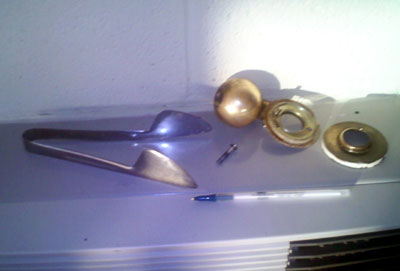
I tested them for tightness. One was actually a little loose, but I couldn't get it to turn with my fingers. I jammed one end of the tong head into the middle, pushed hard, and turned … maybe, just maybe. It turned. Just a little, but it turned. Ten minutes later, both screws were out. I removed the backing plate and now all I had to do was push the rest of the lock out through the front of the door and reach inside the door hole and pull on the latch. Whew.
If only it were that easy. The knob spun freely but was caught up inside the door's hollow core, preventing me from shoving it out the other side. I wedged the tongs under the little t-shaped part of the latch that normally connects to the inside of the knob, but couldn't pull it far enough to unlatch the door. Curses! Foiled again.
It took a few more minutes of twisting the knob into just the right place and shoving it as far inside the door as possible to gain the millimeters I needed, but I finally got it done and the latch clicked open with a satisfying snick.
Free at last, thank Garlits I'm free at last.
I snatched victory from the jaws of defeat, so that, "OMG, do you remember when Phil got locked in the suite; that was soooo funny" will now go into the annals of ND Indy fame as "How cool is he?" At least that's how I see it.
I also have some very fond memories of the bottom floor. It was from small offices there that the National Dragster staff pounded out (on typewriters!) the first edition of the Daily Dragster in 1988, and, in 1997, it was from the ground floor that we broadcast the first ever live “audiocast” of an NHRA event, a feed from the announcers that we streamed free on NHRA.com decades before there was a video accompaniment like NHRA.tv.
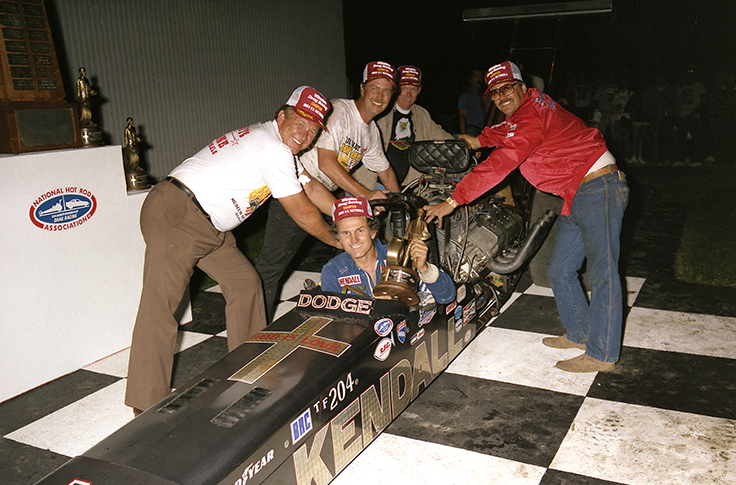
The other great thing about the addition of the Parks Tower was the creation in 1984 of a better winner’s circle environment. A checkerboard-paved area was created at the base of the tower to which the winning vehicles were towed and the winners honored. Among the first in that new hallowed spot was Don Garlits, who scored one of the great “comeback” wins of all time at the 1984 event. The winner’s circle ceremony had previously been held at the top end, at the base of the older tower, and remained in front of the Parks Tower until it was moved to the staging lanes in 2001.
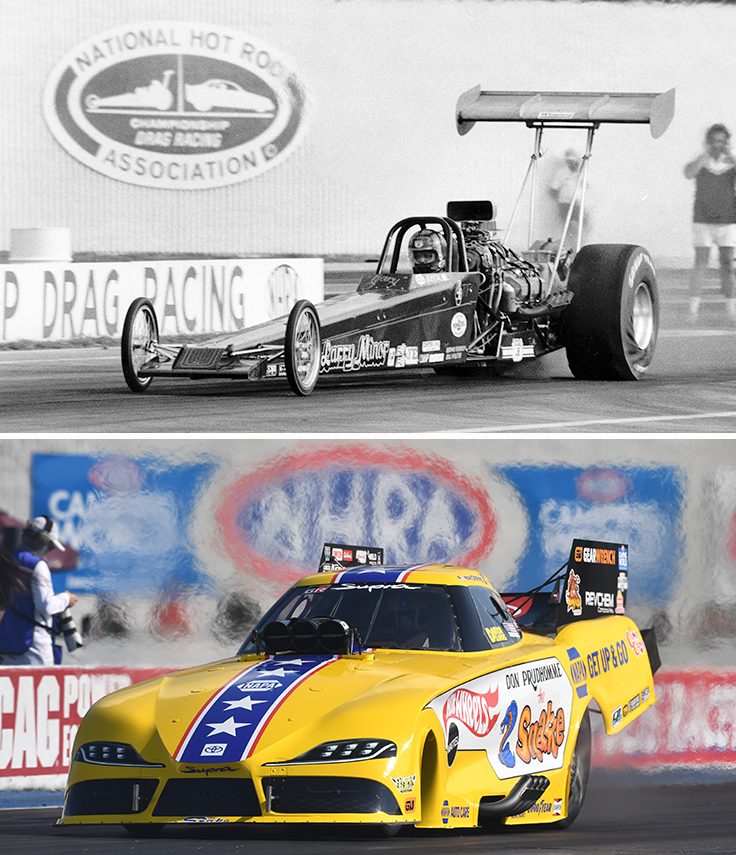
The tower also served as an amazing backdrop to photos, akin to the burger stand at Irwindale Raceway, especially after a giant NHRA oval was added to the base. It made for some great marketing-style photos and was instantly recognizable to everyone.
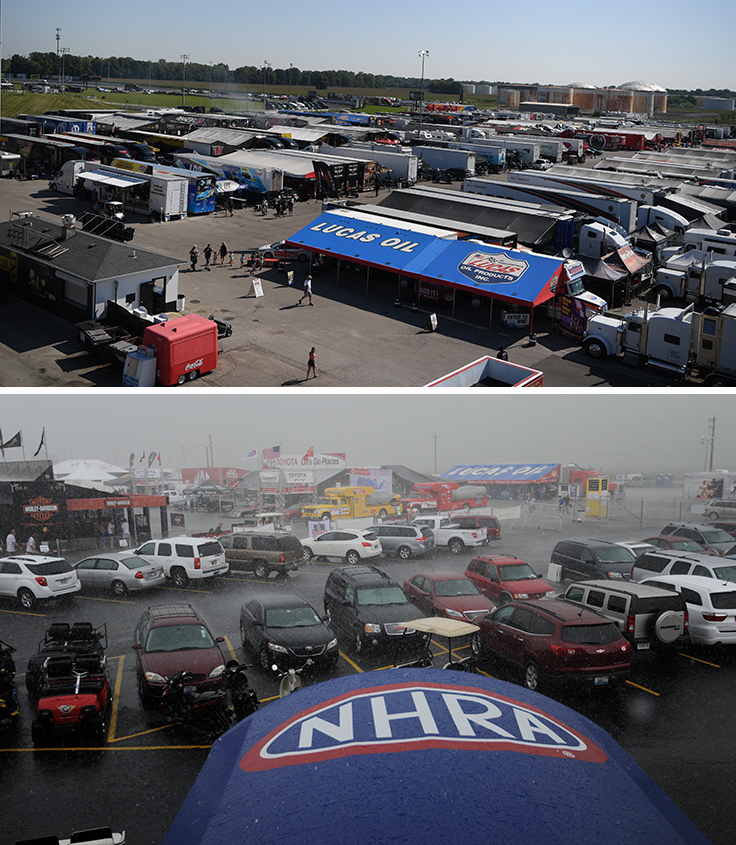
The rear of the Parks Tower afforded a commanding view of the Pro pits (which were relocated there from the west side in 1980) and Manufacturers Midway or, of course, it being summertime in Indianapolis, any approaching rainstorm.

As mentioned earlier, the creation of the Parks Tower also led to the temporary removal of the famed crossover bridge, which was relocated to the back of the approach lanes and capped in 2003 with a great addition, an arch with the track name and NHRA oval that gave our photogs some great backgrounds for pre-race shots.
The opulence of the Parks Tower laid the groundwork for similar structures which soon appeared at Gainesville Raceway and other tracks, which spawned the new familiar track-spanning towers first seen at Texas Motorplex in 1986 and duplicated at venues like Englishtown, Houston, Richmond, Bristol, St. Louis, and Topeka, to name a few.
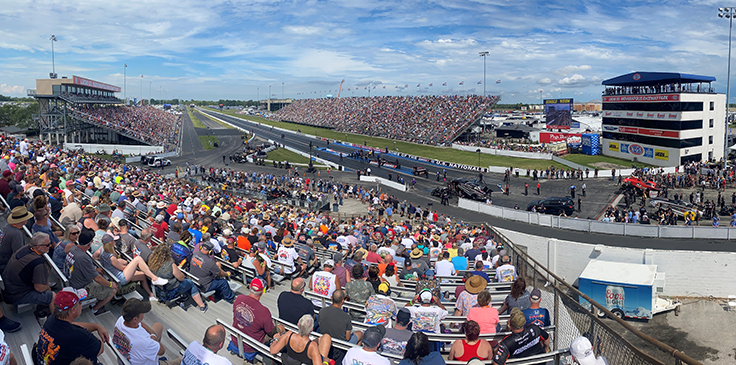
While most of you never had (or will) get the chance to watch a race from within their walls, they still provide the landmark background to photos that allow most fans to identify the location of a photo easily.
A new media/race control tower is planned for the spot of the Parks Tower, but, from the rendering I’ve seen, will be a two-story tower, as you see in Las Vegas, Norwalk, or Sonoma, and before long we’ll be enjoying the creation of new Indy memories from there.

Perhaps presciently, the lovely and talented Kelly Wade and I climbed to the roof of the Parks Tower at the end of last year's race for a celebratory selfie after having again survived the event (my 40th).
Indy may never look the same again, but we’ve seen that countless times across countless tracks. Nothing lasts forever, except your memories.
Phil Burgess can be reached at pburgess@nhra.com
Hundreds of more articles like this can be found in the DRAGSTER INSIDER COLUMN ARCHIVE
Or try the Random Dragster Insider story generator




















































